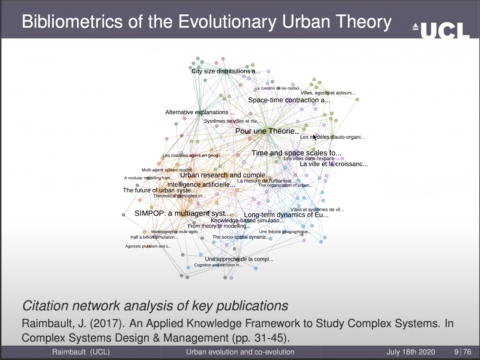line
Generative models of urban form

In the the second instalment of this year’s seminar series, we continued to host a dialogue about the adaptation of evolutionary thinking to the study of cities. We were delighted to host Juste Raimbault, from University College London.
Dr. Raimbault is the author of a stream of very interesting work on theories and models of urban evolution, coupled with epistemological insights about the value and meaning of interdisciplinarity. This work informs own theorizing in Parts I, II, and III of “Towards a Model of Urban Evolution” — which thanks to Dr. Raimbault’s critical commentary we will continue to revise under the more appropriate heading, “Towards a meta-model of urban evolution.”
For our seminar, Dr. Raimbault presented his paper on “Modelling urban evolution and co-evolution in systems of cities.? The abstract is below, and a recording of the presentation may be viewed here.
Systems of cities are adaptive complex systems, which have been theorized and modelled from many viewpoints and by different disciplines. Understanding the processes driving their dynamics is a crucial challenge for sustainable urban and territorial planning. The concept of urban evolution has proved relevant in this regard. This presentation summarises recent results obtained within the frame of the Evolutionary Urban Theory, a geographical approach to urban systems dynamics developed for more than 20 years by Denise Pumain and collaborators. We first review the main theoretical assumptions underlying this theory and results obtained with different simulation models in previous works. We also highlight the role of new model exploration and validation practices and tools developed in that context, implemented in the OpenMOLE platform.
We then describe a model of urban evolution positioned in this approach, in which the diffusion of innovations between cities captures transformation processes (mutations) and transmission processes (diffusion), using two coupled spatial interaction models. Explorations of the model on synthetic systems of cities show the role of spatial interaction and innovation diffusion ranges on measures of diversity and utility, and the existence of intermediate interaction ranges yielding an optimal utility. Multi-objective optimization shows how the model produces a compromise between utility and diversity.
The last part of the presentation focuses on the concept of co-evolution in urban systems, proposing a specific definition, a method to characterize it based on circular causations, and an application to the co-evolution between transportation networks and territories. For this particular case, we summarise results from co-evolution models at the mesoscopic scale (co-evolution between urban form and road networks) and at the macroscopic scale (co-evolution between cities and urban networks). We finally discuss perspectives towards more complex and multi-scalar models of urban evolution.


Leave a Reply
You must be logged in to post a comment.